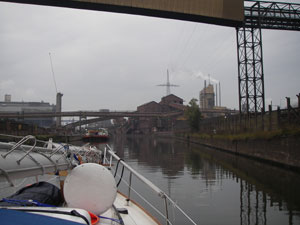|
|
|
From Strijensas to Antoing/Belgium |
||
|
We have now been in Paris for a while and decided to spend some time settling down. We have not looked at any sights yet, as we will have plenty of time to do that later. We intend to stay the winter here. As I am updating our website and thinking back on our experiences in Belgium they almost seem unreal. We planned to get through Belgium in 3-4 days. As it happens it took us 16 days. What we describe below is how we experienced Belgium - seen through the perspective of a boat traveling through the canals. We got a picture that is real for us. It might not be realistic for somebody else. What we can establish though, is that everything has a good and a bad side – this applies also for Belgium. Here follows our story:
|
||
|
After having taken the mast down in Strijensas, the boat felt a bit strange with the mast laying on the deck instead of standing on it. We followed the canal from Willemstad to Antwerp and did not encounter any problems on the way. Just before the border we changed the courtesy flag and wondered whether we would be subjected to a border check or not. A police boat did come alongside us, circling us and then waved as they carried on.
|
 |
|
|
The harbour was just enormous. It took us over two hours to get through and eventually in to the guest harbour in Willemdock. As we chose this guest harbour we did not have to take into account the tidal waters. The Harbourmaster met us in his rubber dinghy and showed us to a place to moor. When we “checked in” he asked for our FD number. We didn´t have such a number as we hadn´t been in contact with anybody before then. He asked if we had seen the police on our way in and when we confirmed that we had, and that they waved to us, his reaction was: “Yes, they usually do that!”
|
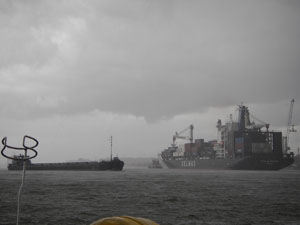 |
|
|
When you are in the waters of Antwerp you will need an FD number, i.e. an identification number, to expedite checks and transit through the locks. Already whilst contacting the lock by VHF the number is required. The Harbourmaster fixed this number for us the next day.
|
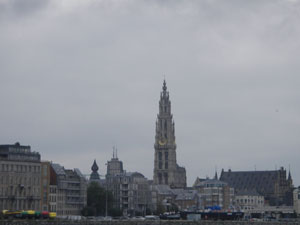
|
|
|
We stayed in Antwerp for two nights, thus giving us a whole day to look around and also purchase a guide over the Belgian canals. There was a maritime books shop quite near to the harbour where we bought “Map of the Belgian Waterways * All information on 4 maps”. It seemed very good with descriptions of locks, bridges, VHF numbers, etc. and cost us €23.
|
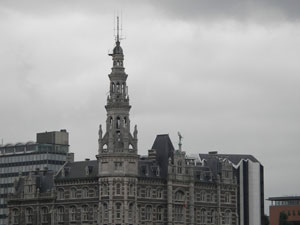 |
|
|
We made our way towards the centre of town and the famous Cathedral. We saw a street with no traffic at all and decided to go that way. It seemed quieter. There were shop window after shop window along the street and it took a while before I realized what was sold here. A shocking experience, to say the least. To see all these half naked women selling themselves in this degrading way… It was 11 a.m. and business was rife. We were pondering how these women got here in the first place…
|
INGA BILDER ! | |
|
We reached the Cathedral eventually after having zigzagged through a lot of building work that seemed to be everywhere. The Cathedral was quite fantastic and well worth visiting. Especially to see the fine paintings by Rubens and the intricate woodwork everywhere.
|
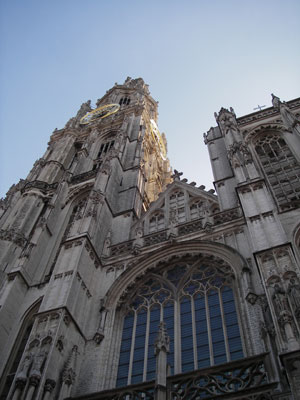 |
|
|
The next day, 28th September, we got out on the river Zeeschelde just as the tide was coming in. This way the tide helped us along the river to the lock Wintam, which is the entrance to the canal leading to Brussels. At this lock we paid a Vinjett/Fee of €25 for traveling on Belgian waters. Our Guide/Map, which we had bought, was very confusing as it didn´t describe reality as it was. We experienced this during our whole stay in Belgium. Distances didn´t check out, there were missing bridges, VHF-numbers were not the right ones, moorings didn´t exist, some canals were closed or didn´t exist, routes changed, etc. Our conclusion: We would not recommend this folder to any future visitors of Belgian waterways. |
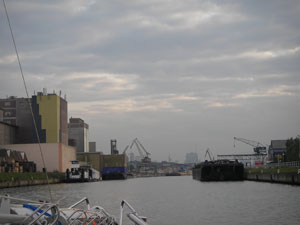 |
|
|
We stayed only one night in Brussels as we planned to carry on down to the river Sambre for our crossing over to France. Our impression of Brussels, and the surrounding area seen from the canal, was that it was dirty and the buildings were derelict. The windows were covered up with shutters and the houses looked all closed. The canal was full of all kinds of rubbish and debris floating around, not to mention all the plastic everywhere. We were kept busy trying to avoid it all and keeping our fingers crossed that the propeller would be all right.
|
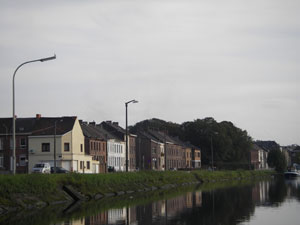 |
|
|
I have seldom come across such unpleasant people as the lock-keepers in this area. The odd one you could forgive for waking up on the wrong side of the bed, but this was quite incredible. An example: We called the lock in English, but got an answer in French. My school French ( 1 year 37 years ago!) leaves a lot to be desired. When I called them in very broken French that we were a Swedish boat and apologized profusely with a lot of “pardon” that I didn´t speak French, the answer came back in perfect English: “Do you speak English?” In almost every lock we had to produce our “circulation paper”, i.e. a form with all the facts about our boat together with the route we planned to take. They seemed to have full control – who we were and where we were going.
|
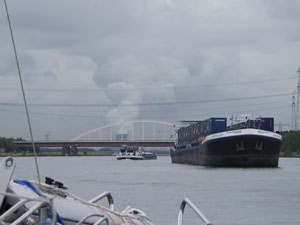 |
|
|
The locks were very deep, which required a lot of rope (at least 30m / fore and aft) to keep the boat in place as most of the locks went up. The barge owners were very kind and let us tie up alongside – which made life a lot easier. All the locks didn´t have floating bollards which made things more difficult. Sometimes a lock keeper would come out with a big hook on a line, which he lowered down. He then pulled our rope up and put it around a bollard. Our problem was to convince the lock keeper that we needed two ropes – one in the front and one in the back of the boat, to keep the boat in place. We quickly realized that the locks were not built for pleasure craft such as ours, but for bigger ships and barges.
|
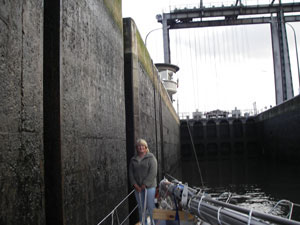 |
|
|
We also found it most difficult to find mooring places anywhere. But at the lock Ittre there was a small guest harbour with showers (very good!) and toilets. Nevertheless, the pontoon was half rotten and you had to tread very carefully not to go through.
|
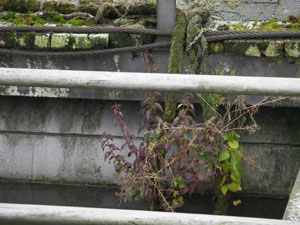 |
|
|
After this lock we had a fantastic experience going up on the “ship-lift” at Ronquieries. Once up at the top we encountered a completely different world: Fields, grazing cows, lush foliage on the trees and fresh air. It was very picturesque. After a few hours we started our descent towards Marchenne-au-Pont and Charleroi. We did not reach the lock in Marchienne-au-Pont in time and thus had to moor for the night just before it. |
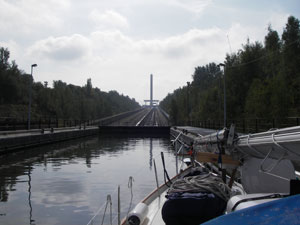 |
|
|
The canal hooked around Charleroi before it turned to the other side of Marchienne-au-Pont. It went through, as we first thought, a derelict factory site. Then we discovered that people were actually working there and that there were several barges loaded with scrap metal. The air was thick with pollution and it stung in our throats and noses as we breathed. Right at the edge of this steelworks there was the town of Marchienne-au-Pont. It looked almost empty as we pottered through it and came out the other side. It felt good to breathe fresher air again.
|
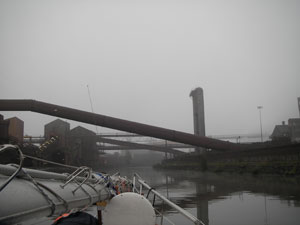 |
|
|
When we got to the first lock we understood from the lockkeeper that the canal was closed further down. Our only option was to turn back. When we got back to Marchienne it was quite late and we decided to stay the night. Here we also found moorings for smaller boats!
|
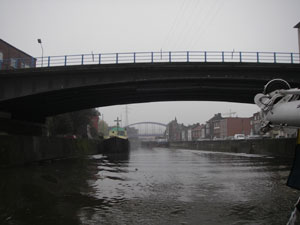 |
|
|
We decided to stock up on food and diesel. We were very surprised to see the supermarket “Champion” behind a high fence and a locked gate. It was Monday and the shop didn´t open until later in the day. There was a queue with people waiting to get in. Diesel we got from an “ordinary” petrol station quite a while away and our trolley came in handy again. As soon as we had finished our stocking up we closed every conceivable hole in the boat so that we didn´t have to breath the contaminated air. I have never experienced such a strong urge to get away from a place as this occasion. At the same time a great reluctance against having to go through Charleroi again.
|
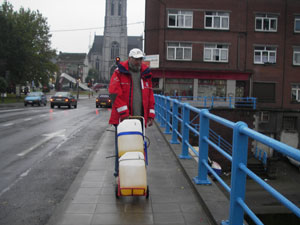 |
|
|
Before we left Belgium we met a nice couple, whom we had a nice chat with, and described our experiences in Marchienne. I was searching for words to describe the expression on people´s faces. “Like hell” the Belgian couple described it. Personally it seemed to me that people were living without hope. At least we had the opportunity to get away…
|
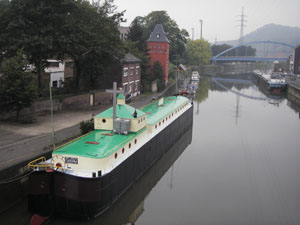 |
|
|
On the journey back through Charleroi we both had masks on to minimize breathing in the pollution. Over the top? Absolutely not! We also took some pictures of the graffiti on the walls. Unfortunately, the pictures didn´t turn out too well, but here is one which the painter describes as “Urban Dream”.
|
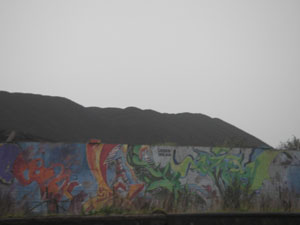 |
|
|
It was time to go through the locks again. The female lockkeeper, who wanted to see our “circulation paper”, was very surprised and explained to us that the route through Sambre was closed for repairs. It seemed that all the surrounding canals were also closed for various reasons. Our only choice was to get back to Wintam (the lock near Antwerp) – carry on to Gent and then down to France. We were of course baffled as we asked ourselves: Why hadn´t anybody said anything to us earlier? We had been checked and controlled umpteen times during our travels…Nevertheless, with the attitude that there is a reason for everything we carried on our journey back.
|
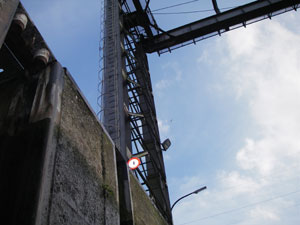 |
|
|
The ship-lift at Ronquieries was just as fantastic on the journey back although it was quite dark by the time it was our turn to descend.
|
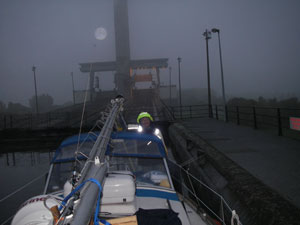 |
|
|
On the journey back to Brussels we encountered all the earlier lockkeepers again. This time around they seemed a bit nicer… Just before we reached the BRYC (Brussels Royal Yacht Club) we heard a “thud!” under the boat. We thought that we must have hit something and hoped that the damaged wouldn´t be too bad. We moored and looked forward to the next day.
|
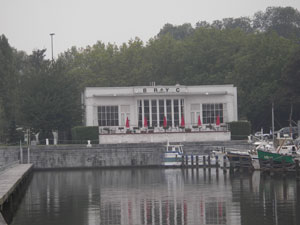
|
|
|
Quite right – our fears were verified – building site plastic around the propeller. It took a while for Mike to get rid of all of it. When the job was finished he had to scrub himself well after being in that filthy water!
|
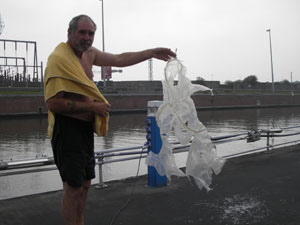 |
|
|
As we planned to get onto the river Schelde, we sat down to work out the tides again. We worked out that the best time to leave would be on the 9th October for us to catch the flood up the river from Wintam towards Gent. Our goal was to get to the outskirts of Gent, before we turned down on to Haut Escaut and the journey down towards the French border. The tide gave us a great push and we were doing up to 9,5 knots getting nearer to Gent at breakneck speed. Due to earlier delays in locks we were a bit concerned about getting to Gent before the tide turned…but sighed a sigh of relief when we realized that we would make it. As we went through the lock into Haut Escaut or Boven Schelde it started to get dark. At the same time clouds were building up and it started to rain. We kept an eye out for moorings, but didn´t see any anywhere. In the end we glimpsed a bay in Gavere with moorings for smaller boats. By then it was 22.20! We slept well that night!
|
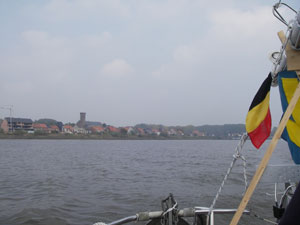 |
|
|
The surroundings here in Flanders were completely different to the areas of Vlaams Brabant and Brabant Wallon. You could quite clearly see that this was a “richer” area with a different architecture. The people were more open, waved and smiled and even spoke English. We understood later that there exists tension between the different areas of Belgium. What we noticed clearly was the difference in language use in the various areas. Flemish in one area and French in the other.
|
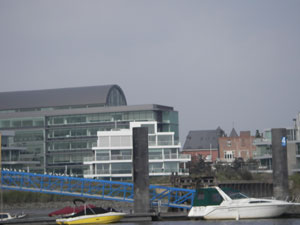 |
|
|
The next day we had a very pleasant leg down to Antoing, our last stop before the French border. Here we met a very nice Belgian couple on their way home from France. They welcomed us with a bottle of Champagne and a very nice chat. Through this meeting we got a more varied view of Belgium… and a lot of good advice for the rest of our journey. In Antoing we stocked up with food and diesel again.
|
The camera took a break! | |
|
A little food for thought: We had quite a lot of time to see the country, at least along the canals. Of course we had our prejudged view about how it would be, i.e. a country well off and an example for the rest of Europe as the EU Parliament is in Brussels. We were very surprised to see all the dereliction, dirt and pollution along the canals. Marchienne-au-Pont is amongst the worst either of us has seen – and we have seen quite a lot. Then we saw the “highland plateau”, which was fertile, lush and green as a contrast. Flanders was also beautiful.
Barge after barge with scrap metal from our welfare living went down to Charleroi and Marchienne, where it was taken care of. You have to take it somewhere and somewhere somebody has to work with it. And the people working with it have to live somewhere. But do they have to, slowly but surely, get poisoned? Is it up to us to be concerned about what is happening in Belgium?
The air that we breathe does not see any borders between countries. It is just floating around. That is why it is our joint responsibility, when it comes to environmental questions, to think in the long perspective.
Margot! Carry on fighting for the environmental questions in the EU!
Here a picture of Brussels.
|
|
|
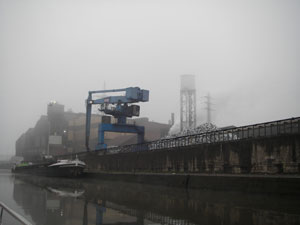 |
||
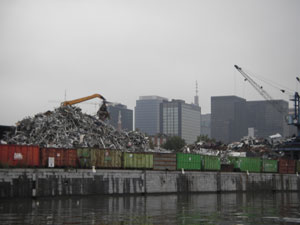 |
||
